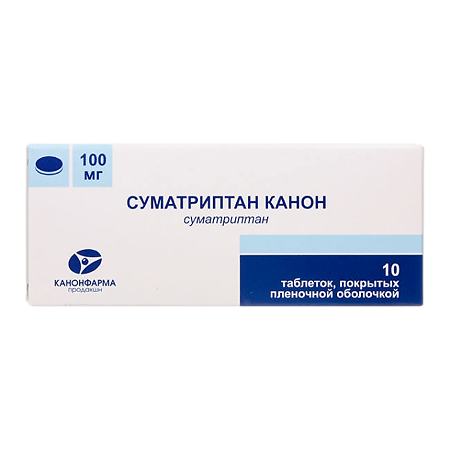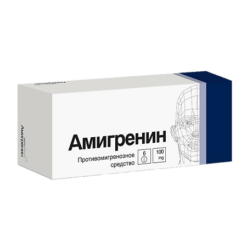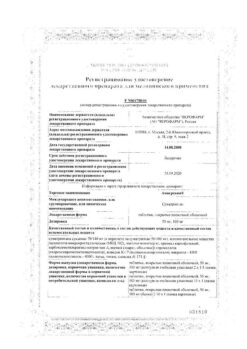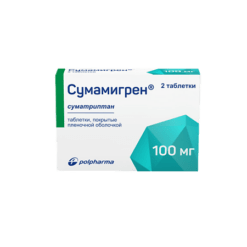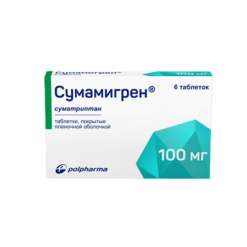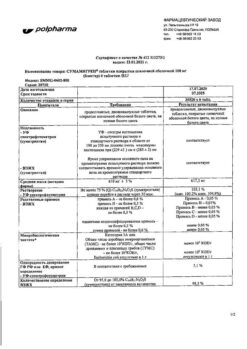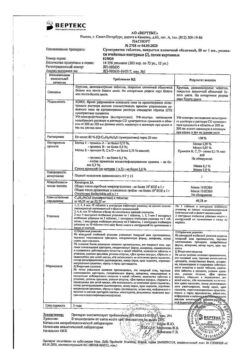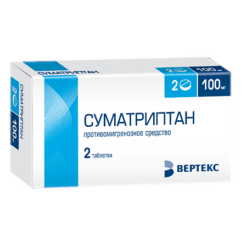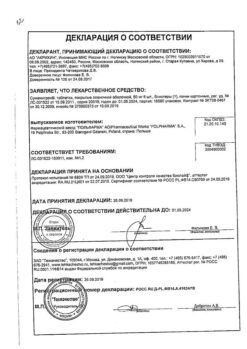No products in the cart.
Sumatriptan Canon, 100 mg 10 pcs
€19.26 €16.05
Description
Pharmacodynamics
Sumatriptan is a selective agonist of vascular 5-hydroxytrypta-
min-1 receptors (5-HT1D) and does not act on other 5-HT receptor subtypes (5-HT2-5-HT7). 5-HT1D receptors are located mainly in the cranial blood vessels of the brain, and their stimulation leads to narrowing of these vessels.
In animals, sumatriptan selectively acts on vasoconstriction of carotid artery branches without affecting blood flow in cerebral vessels. The carotid artery vascular basin supplies blood to extracranial and intracranial tissues (including meningeal membranes), it is believed that dilation of cerebral membrane vessels and/or their edema is the main mechanism of migraine development in humans.
In addition, experimental evidence suggests that sumatriptan reduces trigeminal nerve sensitivity. Both of these effects may underlie the antimigraine action of sumatriptan.
Sumatriptan has demonstrated efficacy in the treatment of migraine attacks, including menstrual-associated migraine.
The onset of action is 30 min after an oral dose of 100 mg. Although the recommended oral dose is 50 mg, migraine attacks vary in severity from patient to patient. Doses of 25 mg to 100 mg have shown greater efficacy than placebo in clinical trials, but the 25 mg dose is statistically significantly less effective than 50 mg and 100 mg.
Pharmacokinetics
Migraine attacks have no significant effect on the pharmacokinetics of sumatriptan taken orally.
Introduction
After oral administration, it is rapidly absorbed, after 45 min its plasma concentration reaches 70% of the maximum level. The average value of absolute bioavailability is 14%, partly due to presystemic metabolism, partly due to incomplete absorption. The mean value of maximum plasma concentration (TCmax) after oral administration of 100 mg is 54 ng/ml.
Distribution
The binding to plasma proteins is 14-21%, the mean total distribution volume is 170 L.
Metabolism
The main metabolite, the indoleukasic analog of sumatriptan, is excreted primarily with the urine, as free acid and glucuronide conjugate. This metabolite has no activity against 5-HT1- and 5-HT2-serotonin receptors.
Secondary metabolites of sumatriptan have not been detected.
Elimination
The elimination half-life (T1/2) is approximately – 2 h. Mean total plasma clearance is 1160 ml/min; mean renal clearance is 260 ml/min; extrarenal clearance is about 80% of total clearance.
Sumatriptan is metabolized by monoamine oxidase A.
Pharmacokinetics in patients in special groups
In patients with impaired hepatic function, the bioavailability of the drug may be significantly increased due to increased plasma concentrations of sumatriptan as a result of decreased presystemic clearance.
The effect of moderate hepatic impairment (Child-Pugh class B) on the pharmacokinetics of sumatriptan when administered subcutaneously has been evaluated. No significant differences were found in the subcutaneous pharmacokinetics of sumatriptan in patients with moderate hepatic impairment compared to healthy control patients.
Indications
Indications
Relief of migraine attacks with or without aura, including attacks of menstrually associated migraine.
Pharmacological effect
Pharmacological effect
Pharmacodynamics
Sumatriptan is a selective vascular 5-hydroxytriptan agonist.
min-1 receptors (5-HT1D), does not affect other subtypes of 5-HT receptors (5-HT2-5-HT7). 5-HT1D receptors are located primarily in the cranial blood vessels of the brain, and their stimulation causes these vessels to constrict.
In animals, sumatriptan selectively acts on vasoconstriction of the branches of the carotid artery without affecting blood flow in the vessels of the brain. The vascular basin of the carotid artery supplies blood to extracranial and intracranial tissues (including the meningeal membranes), and it is believed that dilatation of the meningeal vessels and/or their edema is the main mechanism for the development of migraine in humans.
In addition, experimental data suggest that sumatriptan reduces the sensitivity of the trigeminal nerve. Both of these effects may underlie the antimigraine action of sumatriptan.
Sumatriptan has demonstrated effectiveness in the treatment of migraine attacks, including menstrually associated migraine.
The onset of action is 30 minutes after oral administration at a dose of 100 mg. Although the recommended oral dose is 50 mg, migraine attacks vary in severity within and between patients. Doses of 25 mg to 100 mg have been shown to be more effective than placebo in clinical studies, but the 25 mg dose is statistically significantly less effective than 50 mg and 100 mg.
Pharmacokinetics
Migraine attacks do not have a significant effect on the pharmacokinetics of sumatriptan taken orally.
Suction
After oral administration, it is quickly absorbed, after 45 minutes its plasma concentration reaches 70% of the maximum level. The average absolute bioavailability is 14%, partly due to first-pass metabolism and partly due to incomplete absorption. The average maximum plasma concentration (TCmax) after oral administration of 100 mg is 54 ng/ml.
Distribution
Bonding with plasma proteins is 14-21%, the average total volume of distribution is 170 l.
Metabolism
The main metabolite, the indoleacetic analogue of sumatriptan, is excreted primarily in the urine as the free acid and glucuronide conjugate. This metabolite has no activity against 5-HT1 and 5-HT2 serotonin receptors.
No minor metabolites of sumatriptan were detected.
Removal
The half-life (T1/2) is approximately 2 hours. The average total plasma clearance is 1160 ml/min; average renal clearance – 260 ml/min; extrarenal clearance – about 80% of the total clearance.
Sumatriptan is metabolized by monoamine oxidase A.
Pharmacokinetics in special groups of patients
In patients with impaired liver function, the bioavailability of the drug may be significantly increased by increasing the plasma concentration of sumatriptan as a result of a decrease in presystemic clearance.
The effect of moderate hepatic impairment (Child-Pugh class B) on the pharmacokinetics of sumatriptan when administered subcutaneously was assessed. There were no significant differences in the pharmacokinetics of subcutaneous sumatriptan in patients with moderate hepatic impairment compared with healthy controls.
Special instructions
Special instructions
The drug should be prescribed only if the diagnosis of migraine is beyond doubt.
The drug is contraindicated for use in hemiplegic, basilar and ophthalmoplegic forms of migraine.
Before starting treatment, it is necessary to exclude types of potentially dangerous neurological pathology (for example, stroke, transient ischemic attacks) in the case where the patient has atypical symptoms or when the patient has not been diagnosed with a condition requiring the use of the drug.
After taking the drug, transient symptoms may occur, including pain and tightness in the chest, which may be intense and extend to the neck area. If there is reason to believe that these symptoms are a manifestation of coronary artery disease, it is necessary to conduct an appropriate diagnostic examination.
The drug should not be used in patients with risk factors for the development of coronary artery disease, including heavy smokers or users of nicotine replacement therapy, without prior examination of the cardiovascular system.
Particular attention should be paid to postmenopausal women and men over 40 years of age with these risk factors. However, the examination does not always reveal heart disease in every patient.
In very rare cases, serious adverse reactions from the cardiovascular system may occur in patients with no history of cardiovascular pathology.
The drug should be used with caution in patients with controlled arterial hypertension, since a transient increase in blood pressure and peripheral vascular resistance was observed in a small number of patients.
There are rare reports from post-marketing surveillance of the development of serotonin syndrome (including mental status disorders, autonomic lability and neuromuscular disorders) as a result of concomitant use of selective serotonin reuptake inhibitors (SSRIs) and sumatriptan.
The development of serotonin syndrome has also been reported during concomitant use of triptans and selective norepinephrine reuptake inhibitors (SNRIs). In case of simultaneous use of drugs from the group of SSRIs and/or SNRIs, the patient’s condition should be carefully monitored.
Concomitant use of any triptan (5-HT1 agonist) with sumatriptan is not recommended.
Sumatriptan should be used with caution in patients in whom the absorption, metabolism, or excretion of sumatriptan may be significantly altered, such as patients with hepatic impairment or renal impairment (Child-Pugh class A or B).
Sumatriptan should be used with caution in patients with a history of seizures or other risk factors for lowering the seizure threshold, as seizures have been reported with sumatriptan.
In patients with hypersensitivity to sulfonamides, when administered sumatriptan, there is an increased risk of developing allergic reactions (from skin manifestations to anaphylactic shock). Cross-sensitivity data are limited and caution should be exercised before administering sumatriptan to these patients.
Adverse reactions may occur more frequently during concomitant use of triptans and herbal preparations containing St. John’s wort (Hypericum perforatum).
Overuse of medications intended to treat acute headaches is associated with increased headaches in sensitive patients (drug-overuse headache). In this case, the possibility of discontinuing the drug should be considered.
Impact on the ability to drive vehicles and machinery
Patients with migraine may experience drowsiness associated both with the disease itself and with the use of the drug. During the treatment period, care must be taken when driving vehicles and when working with moving mechanisms.
Active ingredient
Active ingredient
Sumatriptan
Composition
Composition
1 film-coated tablet, 100 mg contains:
active ingredient: sumatriptan succinate 140.00 mg, equivalent to sumatriptan 100.00 mg;
excipients: hyprolose (hydroxypropylcellulose Klucel LF) 8.00 mg, calcium hydrogen phosphate dihydrate 88.00 mg, croscarmellose sodium 6.00 mg, magnesium stearate 4.00 mg, mannitol 97.92 mg, calcium stearate 2.08 mg, microcrystalline cellulose 54.00 mg;
composition of the film shell: Selecoate AQ-02003 14.00 mg, including: [hypromellose (hydroxypropyl methylcellulose) 8.4 mg, macrogol (polyethylene glycol 6000) 2.8 mg, titanium dioxide 2.8 mg].
Pregnancy
Pregnancy
Pregnancy
The use of sumatriptan during pregnancy is possible only if the expected benefit to the mother outweighs the possible risk to the fetus.
Data obtained from the use of sumatriptan in more than 1000 women in the first trimester of pregnancy do not contain sufficient information to draw definitive conclusions about the risk of congenital malformations in the fetus; experience with the use of sumatriptan in the second and third trimesters of pregnancy is also limited.
The results of preclinical studies in animals did not show a direct teratogenic effect of sumatriptan on the fetus or a negative effect on the prenatal and postnatal development of the embryo or fetus in rats. However, there is evidence of the effect of sumatriptan on the viability of the embryo and fetus in rabbits.
Breastfeeding period
Following subcutaneous administration, sumatriptan has been shown to be excreted into breast milk. Breastfeeding should be stopped while using sumatriptan; breastfeeding is possible no earlier than 12 hours after taking the drug.
Contraindications
Contraindications
Hypersensitivity to any of the components of the drug.
Hemiplegic, basilar or ophthalmoplegic forms of migraine.
Coronary heart disease (CHD), (including suspicion of it), angina pectoris (including Prinzmetal’s angina), myocardial infarction (including history), post-infarction cardiosclerosis, as well as symptoms suggesting the presence of coronary heart disease.
Moderate to severe arterial hypertension, mild uncontrolled arterial hypertension.
Occlusive diseases of peripheral arteries.
Stroke or transient ischemic attack (including a history).
Severe dysfunction of the liver and/or kidneys.
Concomitant use with ergotamine or its derivatives (including methysergide) or other tryptamines/5-HT1 receptor agonists.
Use while taking monoamine oxidase inhibitors (MAOIs) or earlier than 2 weeks after discontinuation of these drugs.
Ages under 18 and over 65 years of age (efficacy and safety have not been established).
With caution:
Epilepsy (including any conditions with a reduced epileptic threshold).
Arterial hypertension (controlled).
Diseases that may alter the absorption, metabolism or excretion of sumatriptan (for example, impaired renal or hepatic function).
Hypersensitivity to sulfonamides (administration of sumatriptan can cause allergic reactions, the severity of which varies from skin manifestations to anaphylaxis). Cross-sensitivity data are limited, but caution should be exercised when prescribing sumatriptan to such patients.
Side Effects
Side Effects
The adverse reactions presented below are listed according to organ damage and frequency of occurrence. Frequency is defined as follows:
very common (≥1/10), common (≥1/100 and <1/10), uncommon (≥1/1000 and <1/100), rare (≥1/10000 and <1/1000), very rare (<1/10000), unknown (frequency cannot be estimated from the available data).
Clinical trial data
Nervous system disorders:
often – dizziness, drowsiness, sensory disturbances, including paresthesia and decreased sensitivity.
Vascular disorders:
often – a transient increase in blood pressure (observed soon after taking the drug), hot flashes.
Disorders of the respiratory system, chest and mediastinal organs:
often – shortness of breath.
Gastrointestinal disorders:
often – nausea, vomiting (the cause-and-effect relationship between the occurrence of adverse reactions and taking the drug has not been proven).
Musculoskeletal and connective tissue disorders:
often – a feeling of heaviness (usually transient, can be intense and occur in any part of the body, including the chest and throat).
General disorders and disorders at the injection site:
often – pain, a feeling of cold or heat, a feeling of pressure or tightness (usually transient, can be intense and occur in any part of the body, including the chest and throat), weakness, fatigue (usually mild or moderate, transient).
Laboratory and instrumental data:
very rarely – minor deviations in liver test parameters.
Post-registration observation data
Immune system disorders:
frequency unknown – hypersensitivity reactions, including skin manifestations, as well as anaphylaxis.
Nervous system disorders:
frequency unknown – seizures (in some cases observed in patients with a history of seizures or with concomitant conditions predisposing to seizures; in some patients no risk factors were identified), tremor, dystonia, nystagmus, scotoma.
Mental disorders:
frequency unknown – alarm.
Visual disorders:
frequency unknown – flickering, diplopia, decreased visual acuity, blindness (usually transient). However, visual disturbances can be caused by the migraine attack itself.
Cardiac disorders:
frequency unknown – bradycardia, tachycardia, palpitations, arrhythmias, signs of transient myocardial ischemia on the ECG, coronary vasospasm, angina pectoris, myocardial infarction.
Vascular disorders:
frequency unknown – arterial hypotension, Raynaud’s syndrome.
Gastrointestinal disorders:
frequency unknown – ischemic colitis, diarrhea.
Musculoskeletal and connective tissue disorders:
frequency unknown – stiff neck, arthralgia.
Disorders of the skin and subcutaneous tissues:
frequency unknown – hyperhidrosis.
Interaction
Interaction
There was no interaction of sumatriptan with propranolol, flunarizine, pizotifen and ethyl alcohol in healthy volunteers.
When taken simultaneously with ergotamine, prolonged vasospasm was observed.
There is limited data on the interaction of sumatriptan with drugs containing ergotamine or other triptans/5-HT1 receptor agonists. Theoretically, there is a possible increased risk of coronary vasospasm, and the combined use of these drugs is contraindicated (see section “Contraindications”).
The period of time that should elapse between the use of sumatriptan and ergotamine-containing drugs or another triptan/5-HT1 receptor agonist is unknown. It will depend, among other things, on the dose and type of drugs prescribed. The effect may be additive.
It is recommended to wait at least 24 hours after taking medications containing ergotamine or another triptan/5-HT1 receptor agonist before using sumatriptan. Conversely, it is recommended to wait at least 6 hours after using sumatriptan before using drugs containing ergotamine, and at least 24 hours before using another triptan/5-HT1 receptor agonist.
There may be an interaction between sumatriptan and MAO inhibitors; their simultaneous use is contraindicated (see section “Contraindications”).
There are rare reports of the development of serotonin syndrome (including mental disorders, autonomic lability and neuromuscular disorders) as a result of simultaneous use of selective serotonin reuptake inhibitors (SSRIs) and sumatriptan.
The development of serotonin syndrome has also been reported during concomitant use of triptans with selective serotonin norepinephrine reuptake inhibitors (SNRIs).
Overdose
Overdose
Symptoms
When taken orally up to 400 mg, no other adverse reactions are observed other than those listed above in the “Side Effects” section.
Treatment
In case of overdose of sumatriptan, patients should be monitored for at least 10 hours and, if necessary, symptomatic therapy should be provided. There are no data on the effect of hemodialysis or peritoneal dialysis on the concentration of sumatriptan in plasma.
Storage conditions
Storage conditions
At a temperature not exceeding 25 °C in the manufacturer’s packaging. Keep out of the reach of children.
Shelf life
Shelf life
4 years.
Manufacturer
Manufacturer
Kanonpharma production CJSC, Russia
Additional information
| Shelf life | 4 years. |
|---|---|
| Conditions of storage | At the temperature not more than 25 °С in the manufacturer's package. Keep out of reach of children. |
| Manufacturer | Kanonfarma Production ZAO, Russia |
| Medication form | pills |
| Brand | Kanonfarma Production ZAO |
Other forms…
Related products
Buy Sumatriptan Canon, 100 mg 10 pcs with delivery to USA, UK, Europe and over 120 other countries.

